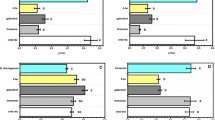Summary
1. The treatment of soil with root exudate solution resulted in increased numbers of Gram-negative bacteria.
2. The oxygen uptake and nitrification of root exudate treated soils were no greater than the controls unless readily decomposable substances such as glucose or peptone were added.
3. The release of phosphate from soil organic matter or yeast nucleic acid was not increased with root exudate supplements.
Similar content being viewed by others
References
Bengtsson, N., Contributions to the question of the nitrification of stable manure in cultivated soil IX. The determination of nitrates in soil and manure Kgl. Landtbr. Akad. Handl. Tidskr. No. 5, 620 (1932).
Bunt, J. S. and Rovira, A. D., Microbiological studies of some subantarctic soils. J. Soil Sci.6, 119 (1955).
Clark, F. E., Notes on types of bacteria associated with plant roots. Trans. Kansas Acad. Sci.43, 75 (1940).
Clark, F. E., Soil microorganisms and plant growth. Adv. Agron.1, 241 (1949).
Gerretsen, F. C., The influence of micro-organisms on the phosphate intake of plants. Plant and Soil1, 51 (1948).
Goring, C. A. and Clark, F. E., Influence of plant growth on mineralization of nitrogen in soil. Soil Sci. Soc. Amer. Proc.13, 261 (1948).
Lochhead, A. G., Qualitative studies of soil micro-organisms III. Influence of plant growth on the character of the bacterial flora. Canad. J. Research C18, 42 (1940).
Rogers, H. J., Dephosphorylation of organic phosphate compounds by soil catalysts. Soil Sci.54, 439 (1942).
Rovira, A. D., The use of the Warburg apparatus in soil metabolism studies. Nature172, 29 (1953).
Rovira, A. D., Some quantitative and qualitative studies of the rhizosphere. Proc. Soil Sci. Conf. Adelaide, June 1953 (1953).
Rovira, A. D., Plant root excretion in relation to the rhizosphere I. The nature of root exudate from oats and peas. Plant and Soil7, 178 (1956).
Rovira, A. D., Plant root excretions in relation to the rhizosphere II. A Study of the properties of root exudate and its effect on the growth of micro-organisms isolated from the rhizosphere. Plant and Soil7, 195 (1956).
Scheel, K. C., Colorimetric determination of phosphoric acid in fertilizers. Z. anal. Chem.105, 256 (1936).
Thom, C., Micropopulations correlated to decomposition processes. Trans. Intern. Congr. Soil Sci. III, 160 (1935).
Timonin, M. I., The interaction of higher plants and soil micro-organisms III. Effect of by-products of plant growth on activity of fungi and actinomycetes. Soil Sci.52, 395 (1941).
Timonin, M. I., Microflora of the rhizosphere in relation to manganese deficiency disease of oats. Soil Sci. Soc. Amer. Proc.11, 284 (1947).
Author information
Authors and Affiliations
Rights and permissions
About this article
Cite this article
Rovira, A.D. Plant root excretions in relation to the rhizosphere effect. Plant Soil 7, 209–217 (1956). https://doi.org/10.1007/BF01666119
Received:
Issue Date:
DOI: https://doi.org/10.1007/BF01666119




